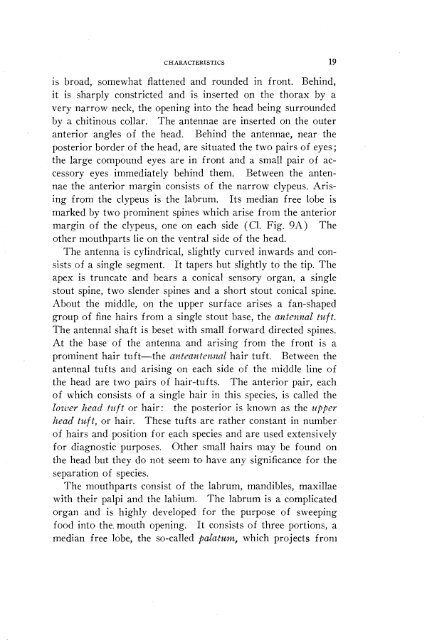a handbook of the mosquitoes of north america - Systematic Catalog ...
a handbook of the mosquitoes of north america - Systematic Catalog ...
a handbook of the mosquitoes of north america - Systematic Catalog ...
Create successful ePaper yourself
Turn your PDF publications into a flip-book with our unique Google optimized e-Paper software.
CHARACTERISTICS 19<br />
is broad, somewhat flattened and rounded in front. Behind,<br />
it is sharply constricted and is inserted on <strong>the</strong> thorax by a<br />
very narrow neck, <strong>the</strong> opening into <strong>the</strong> head being surrounded<br />
by a chitinous collar. The antennae are inserted on <strong>the</strong> outer<br />
anterior angles <strong>of</strong> <strong>the</strong> head. Behind <strong>the</strong> antennae, near <strong>the</strong><br />
posterior border <strong>of</strong> <strong>the</strong> head, are situated <strong>the</strong> two pairs <strong>of</strong> eyes ;<br />
<strong>the</strong> large compound eyes are in front and a small pair <strong>of</strong> ac-<br />
cessory eyes immediately behind <strong>the</strong>m. Between <strong>the</strong> anten-<br />
nae <strong>the</strong> anterior margin colnsists <strong>of</strong> <strong>the</strong> narrow clypeus. Aris-<br />
ing from <strong>the</strong> clypeus is <strong>the</strong> labrum. Its median free lobe is<br />
marked by two prominent spines which arise from <strong>the</strong> anterior<br />
margin <strong>of</strong> <strong>the</strong> clypeus, one on each side (Cl. Fig. 9A) The<br />
o<strong>the</strong>r mouthparts lie on <strong>the</strong> ventral side <strong>of</strong> <strong>the</strong> head.<br />
The antenna is cylindrical, slightly curved inwards and con-<br />
sists <strong>of</strong> a single segment. It tapers but slightly to <strong>the</strong> tip. The<br />
apex is truncate and bears a conical sensory organ, a single<br />
stout spine, two slender spines and a short stout conical spine.<br />
About <strong>the</strong> middle, on <strong>the</strong> upper surface arises a fan-shaped<br />
group <strong>of</strong> fine hairs from a single stout base, <strong>the</strong> a,demzal tuft.<br />
The antenna1 shaft is beset with small forward directed spines.<br />
At <strong>the</strong> base <strong>of</strong> <strong>the</strong> antenna and arising from <strong>the</strong> front is a<br />
prominent hair tuft-<strong>the</strong> anteantcnmd hair tuft. Between <strong>the</strong><br />
antenna1 tufts and arising on each side <strong>of</strong> <strong>the</strong> middle line <strong>of</strong><br />
<strong>the</strong> head are two pairs <strong>of</strong> hair-tufts. The anterior pair, each<br />
<strong>of</strong> which consists <strong>of</strong> a single hair in this species, is called <strong>the</strong><br />
lozver head tzt ft or hair:<br />
hea,d tuft, or hair.<br />
<strong>the</strong> posterior is kno’wn as <strong>the</strong> zapper<br />
These tufts are ra<strong>the</strong>r constant in number<br />
<strong>of</strong> hairs and polsition for each species and are used extensively<br />
for diagnostic purposes. O<strong>the</strong>r small hairs may be found on<br />
<strong>the</strong> head but <strong>the</strong>y do not seem to have any significance for <strong>the</strong><br />
separation <strong>of</strong> species.<br />
The mouthparts consist <strong>of</strong> <strong>the</strong> labrum, mandibles, maxillae<br />
with <strong>the</strong>ir palgi and <strong>the</strong> labium. The labrum is a complicated<br />
organ and is highly developed for <strong>the</strong> purpose <strong>of</strong> sweeping<br />
food into <strong>the</strong>. mouth opening. It consists <strong>of</strong> three portions, a<br />
median free lob’e, <strong>the</strong> so-called palatwn, which projects from

















